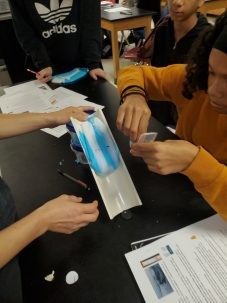On the Road, Teaching Glacier Science
A PhD student explains what life is like on a week-long bicycle trip that’s bringing climate science to students from economically disadvantaged families.

By Elizabeth Hillary Case
This is the second of three blog posts documenting a bicycle trip through the Hudson Valley, led by Columbia University PhD student Elizabeth Hillary Case. Read the first one here, and the third here.
I spent Monday morning preparing my class presentation and packing my bicycle: camping gear in the rear left bag; clothes and bike parts in the rear right; the lab activity in the front left; and my computer, food and Crocs in the front right. Just enough to make it through five days, three classrooms, and a little bit of rain. Finally, after a late lunch, the only thing left to do was actually leave. I rolled my bicycle out of my apartment, and turning north onto Broadway, began to pedal toward the Hudson Valley.
The goal of Cycle for Science is to introduce working scientists to middle- and high-school students who may otherwise lack STEM role models. Simultaneously, we aim to showcase the creativity, hands-on nature, and relevance of climate science and renewable energy.
Rachel and I started Cycle for Science in 2015 after joking for years that we should drop out of our physics programs and bike across the country. We had both taken non-traditional paths into science: Rachel started as a trombone player in the ethnomusicology department and I came to UCLA to be a journalist. What drew us into physics was in part, a shared seminar on the “Arrow of Time.” The class took a qualitative, creative, explanatory approach to the physics of time; it changed the arrow of our lives.
Degrees in hand, we decided to actually cycle across the country. We wanted to see world firsthand at a human pace. As a way to pay our physics education forward, we also wanted to bring hands-on lessons that showcased the creativity and problem-solving aspects of science to students around the U.S. Growing up, we had both lacked female role models in STEM and our early science education lacked relevance, so we set out to create a lesson we would have wanted to experience. As we pedaled through the best of America — up soaring mountain passes, alongside with wild horses, across magnificent rivers — we stopped at libraries, summer camps, and classrooms to share what made science so exciting for us.

This trip is a toned-down version of the original trip. For the last four days, I’ve worked my way up the Hudson Valley, stopping at high school classrooms to talk about how ice sheets shaped the Hudson River as we know it. To help students get a tactile feel for how glaciers flow, I brought along a popular glaciological outreach tool: glacier goo, a.k.a. slime, a squishy non-Newtonian substance made from Elmer’s glue and borax.
The loaded-up bicycle is another fun prop — students always have questions about 1) where I sleep and 2) where I pee. On these trips, I stay with family/friends, camp, or AirBnB, depending on how early I have to get up to teach. As for the second question? Gas stations, grocery stores, and the woods.
The first two classroom visits were on Tuesday and Thursday: two classes of high school freshmen at Riverside High School in Yonkers, and four of freshmen and sophomores at the Newburgh Free Academy. Most of these students come from economically disadvantaged families, and few have role models who are scientists. The most important things I emphasize are: 1) science can be about your local community and its needs; 2) it’s a paid gig; 3) science is a process, not a product; and 4) it can be very fun and take you to wild places. A decade ago, entering university, I didn’t know any of this.
More than 100 miles and many orchard-picked apples later, I’ve reached Poughkeepsie. I’ll teach my last set of classes today, to elementary school students, and then take the train back to New York City. In the next post, I’ll outline the lesson, relate some stories from students, and finish up the trip.
See you on the road!
